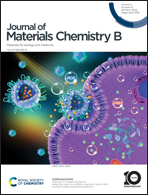A sensitive dual-signal electrochemiluminescence immunosensor based on Ru(bpy)32+@HKUST-1 and Ce2Sn2O7 for detecting the heart failure biomarker NT-proBNP†
Abstract
A sensitive dual-signal electrochemiluminescence (ECL) immunosensor was proposed based on Ru(bpy)32+@HKUST-1/TPA and Ce2Sn2O7/K2S2O8 probes for detecting the NT-proBNP biomarker of heart failure. HKUST-1 with a high specific surface area facilitates the loading of more Ru(bpy)32+, effectively improving the anodic signal intensity, while the emerging Ce2Sn2O7 emitter displays a potential-matching cathodic emission with moderate intensity. Two ECL probes were characterized with field emission scanning electron microscopy, X-ray diffraction, XPS, FT-IR spectroscopy and UV-Vis diffuse reflectance spectroscopy. This dual-signal immunosensor has a wide linear range (5 × 10−4–1 × 104 ng mL−1) and a low quantitative detection limit, simultaneously showing high sensitivity, stability and reproducibility, as well as the detection capability of actual serum samples. This dual signal-calibrated immunoassay platform not only reduces the false positive rate of detection results but also provides a promising method for the early diagnosis of heart failure.



 Please wait while we load your content...
Please wait while we load your content...